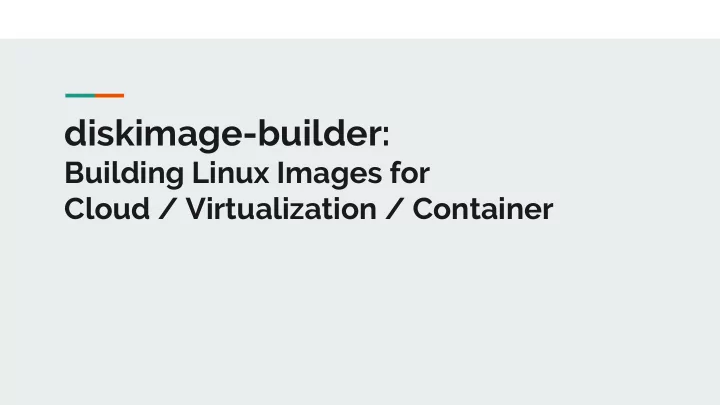

diskimage-builder: Building Linux Images for Cloud / Virtualization / Container
Let’s start with a little bit of history:
Once upon a time...
About the Author Andreas Florath andreas@florath.net Mathematician (RWTH Aachen) Currently living in East-Belgium in Deutschsprachigen Gemeinschaft. Professional software developer since 1994. Preferred languages: C++, python. Active Free and Open Software supporter since 1992. Current projects: diskimage-builder (core developer), rmtoo and creating wooden things with my DIY CNC router.
OS Images Operating System (OS) Images are a copy of a pre-installed operating system. Other names: Golden Image, Template OS Image OS Images are used in virtualization, cloud and container environments.
Building OS Images: Installer Install OS in traditional way and copy the resulting data (manual / automatic) Example: kickstart for RedHat / CentOs / Fedora based systems
Building OS Images: utility Use a program that directly creates an OS image / tree Example: debootstrap for Debian / Ubuntu
Many-To-Many Simultaneously targeting multiple OSes, architectures and environments (virtualization, container, cloud, ...) requires one configuration for each combination.
One to Rule Them All diskimage-builder solves this problem: it creates images for different distributions or architectures for different target platforms based on a single unified configuration.
Examples disk-image-create debian-minimal vm Under the hood: diskimage-builder disk-image-create fedora-minimal vm requires to have system utilities disk-image-create centos-minimal vm (rpm, debootstrap, …) installed - disk-image-create -o docker fedora-minimal and calls / uses them.
qemu is used to execute target binaries (as needed in pre- and Support Matrix postinstall scripts) on the host system. Distributions: Debian, Ubuntu, Fedora, RedHat, Centos, OpenSuse, Gentoo (typically the stable and the last-stable version) Architectures: arm64, i386, amd64/x86_64, powerpc (cross build is supported) Images can be converted into mostly any format - Environments: qemu convert is your VmWare, OpenStack, KVM, AWS EC2, Docker, Bare-Metal. friend.
“Elements”: Batteries Included diskimage-builder comes with about 100 predefined (so called) “elements” for additional features, configuration, adaptions and scripting. Usage: disk-image-create debian-minimal vm puppet-master Many additional elements are available in the Internet - one example: ready to use element for building a Raspberry Pi Image. Usage: disk-image-create debian-minimal vm rpi3 Configurable via environment variables.
Example Elements ● proliant-tools ● baremetal ● selinux-permissive ● cloud-init ● sysctl ● devuser ● uboot ● docker ● vm ● epel ● growroot ● manifests Some packages that clash with others or are ● pip_and_virtualenv highly environment / hardware specific. Read ● ssh-server the element’s documentation!
An Element is... README.rst element-deps package-installs.yaml environment.d root.d
debootstrap dib-python pkg-map An Element is... README.rst element-deps package-installs.yaml linux-image-amd64: environment.d arch: amd64 linux-image-686: root.d arch: i386 export DISTRO_NAME=debian linux-image-arm64: export \ arch: arm64 DIB_RELEASE=${DIB_RELEASE:-stable} netbase: #!/bin/bash apt-get update apt-get clean apt-get dist-upgrade -y ...
Block Device Layer (1/2) Level 4 fstab handling Level 3 Mounting Level 2 File system generation; mkfs (ext, xfs, fat, …) Level 1 Combine / split level 0 / 1 block devices; partitioning, LVM; possible: RAID, cryptsetup, ... Level 0 Provides disk space; loop device; possible: (raw) disk devices, iSCSI, ...
Block Device Layer (2/2) - mkfs: - local_loop: base: root name: image0 mount: mount_point: / - partitioning: fstab: base: image0 options: "defaults" label: mbr fsck-passno: 1 partitions: - name: root flags: [ boot, primary ] size: 100%
Block Device Layer MBR Module It’s about writing 72 bytes to the correct position in the Master Boot Sector! Idea: Use existing tool like fdisk, sfdisk, parted, ... A small Python class war created to write MBRs: Short (~150 LOC), open source, tested, and actually does what you tell it.
Development Insights ‘Small size’ project: ● 12500 LOC: ~7000 bash, ~3000 python , ~2500 yaml block device layer: ~2150 python, ~800 yaml Many adaptions / workarounds for (old and known) problems of various distributions. ● Design should be improved. ● Slow development cycle (CI slow / no developers). ● Many contributors focus on their own feature/bug-fix, rarely review other contributions. ●
One to Rule Them All RECAP diskimage-builder solves this problem: it This is for an ideal creates images for different distributions or architectures for different target platforms based on one world only…. configuration.
Recommend
More recommend